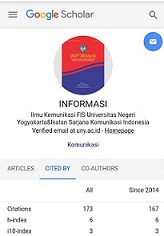Exploring the role of international rankings in the development of institutional public relations strategies
Dian Ayuria Sarwono, BINUS University, Indonesia
Abstract
Keywords
Full Text:
PDFReferences
Achmad, W., Talib, W., & Basri, M. (2021). Multicultural education-based instruction for mental revolution in teaching Intercultural Communication: Indonesian university students’ Perspectives. ELT Worldwide: Journal of English Language Teaching. https://doi.org/10.26858/eltww.v8i1.22299.
Amsler, S., & Bolsmann, C. (2012). University ranking as social exclusion. British Journal of Sociology of Education, 33, 283 - 301. https://doi.org/10.1080/01425692.2011.649835.
Aryani, F., & Umar, N. (2020). Factors Affecting Z Generation on Selecting Majors in The University: an Indonesian Case. Journal of Social Studies Education Research, 11, 109-133.
Balaji, M., Roy, S., & Sadeque, S. (2016). Antecedents and consequences of university brand identification. Journal of Business Research, 69, 3023-3032. https://doi.org/10.1016/J.JBUSRES.2016.01.017.
Barron, G. (2017). The Berlin Principles on Ranking Higher Education Institutions: limitations, legitimacy, and value conflict. Higher Education, 73, 317-333. https://doi.org/10.1007/S10734-016-0022-Z.
Basit, T. (2003). Manual or electronic? The role of coding in qualitative data analysis. Educational Research, 45, 143 - 154. https://doi.org/10.1080/0013188032000133548.
Braun, V., & Clarke, V. (2022, February). Conceptual and design thinking for thematic analysis. Qualitative Psychology, 9(1), 3–26. https://doi.org/10.1037/qup0000196
Bryman, A. (2006). Integrating quantitative and qualitative research: how is it done?. Qualitative Research, 6, 113 - 97. https://doi.org/10.1177/1468794106058877.
Casidy, R., & Wymer, W. (2016). Linking prestige perception with consumption experience, loyalty, and WOM. Marketing Intelligence & Planning, 34, 540-558. https://doi.org/10.1108/MIP-06-2015-0113.
Conard, M., & Conard, M. (2000). An Analysis of Academic Reputation as Perceived by Consumers of Higher Education. Journal of Marketing for Higher Education, 9, 69 - 80. https://doi.org/10.1300/J050v09n04_05.
Dewi, M., Tanjung, S., & Nadira, S. (2019). Optimization of Cyber PR at Private Universities in Yogyakarta. Asian Journal of Innovation and Entrepreneurship, 4, 125-129.
Emerson, R. (2017). Likert Scales. Journal of Visual Impairment & Blindness, 111, 488 - 488. https://doi.org/10.1177/0145482x1711100511.
Erkkilä, T. (2013). Introduction: University Rankings and European Higher Education. Global University Rankings, 3-19. https://doi.org/10.1057/9781137296870_1
Gunarto, M., Nugraha, D., & Gaffar, V. (2016). Analysis of Perception and Public Preference on Reputation of Higher-Education Ranking Agencies. , 364-370. https://doi.org/10.2991/GCBME-16.2016.65.
Harahap, D., & Amanah, D. (2019). Assessment in Choosing Higher Education: A Case of Indonesia. Journal of International Business, Economics and Entrepreneurship. https://doi.org/10.24191/jibe.v4i1.14413.
Khokhar, S., Pathan, H., Raheem, A., & Abbasi, A. (2020). Theory Development in Thematic Analysis: Procedure and Practice.3, 423-433. https://doi.org/10.47067/RAMSS.V3I3.79.
Kusumawati, A., Perera, N., & Yanamandram, V. (2019). Modelling trade-offs in students’ choice set when determining universities. International Journal of Educational Management. https://doi.org/10.1108/IJEM-01-2018-0007.
Lee, Y., Wanta, W., & Lee, H. (2015). Resource-Based Public Relations Efforts for University Reputation from an Agenda-Building and Agenda-Setting Perspective. Corporate Reputation Review, 18, 195-209. https://doi.org/10.1057/CRR.2015.6.
Logli, C. (2016). The Palgrave Handbook of Asia Pacific Higher Education (p. 561–581). Palgrave Macmillan. https://doi.org/10.1057/978-1-137-48739-1_37
Maady, M., Yuwita, P., Ardianti, A., Anggraini, F., & Lestari, I. (2019). Exploring Open Government Partnership as a Strategy for Promoting Transparency in Private University: An Initial Study. Proceedings of the 5th UPI International Conference on Technical and Vocational Education and Training (ICTVET 2018). https://doi.org/10.2991/ICTVET-18.2019.13.
Marginson, S. (2007). Global University Rankings: Implications in general and for Australia. Journal of Higher Education Policy and Management, 29, 131 - 142. https://doi.org/10.1080/13600800701351660.
Ordorika, I., & Lloyd, M. (2015). International rankings and the contest for university hegemony. Journal of Education Policy, 30, 385 - 405. https://doi.org/10.1080/02680939.2014.979247.
Peppercorn, J., Buss, W., Fost, N., & Godley, P. (2008). The dilemma of data-safety monitoring: provision of significant new data to research participants. The Lancet, 371, 527-529. https://doi.org/10.1016/S0140-6736(08)60239-1.
Platz, S., & Holtbrügge, D. (2016). Student Expectations and Experiences in Higher Education: A Comparison of State and Private Universities in Germany. , 171-190. https://doi.org/10.1057/978-1-137-54291-5_8.
Richards, K., & Hemphill, M. (2017). A Practical Guide to Collaborative Qualitative Data Analysis. Journal of Teaching in Physical Education, 37, 225-231. https://doi.org/10.1123/JTPE.2017-0084.
Ronald, R., & Emmerich, S. (2022). Strategi Meningkatkan Participate Interest Mahasiswa terhadap Program Merdeka Belajar Kampus Merdeka. Jurnal Nusantara Aplikasi Manajemen Bisnis. https://doi.org/10.29407/nusamba.v7i2.17026.
Safón, V. (2013). What do global university rankings measure? The search for the X factor and the X entity. Scientometrics, 97, 223–244. https://doi.org/10.1007/s11192-013-0986-8
Smith, M. (2010). Ethics and Research Governance, 41-58. https://doi.org/10.4135/9781446268346.N4.
Su, B., Hu, J., Chen, W., Shen, W., & Lin, C. (2005). Factors Affecting Medical Students' Choice of Residency: A Preliminary Study. Mid-Taiwan Journal of Medicine, 10, 181-188. https://doi.org/10.6558/MTJM.2005.10(4).3.
Thomas, S., Chie, Q., Abraham, M., Raj, S., & Beh, L. (2014). A Qualitative Review of Literature on Peer Review of Teaching in Higher Education. Review of Educational Research, 84, 112 - 159. https://doi.org/10.3102/0034654313499617.
Vaughn, P., & Turner, C. (2016). Decoding via Coding: Analyzing Qualitative Text Data Through Thematic Coding and Survey Methodologies. Journal of Library Administration, 56, 41 - 51. https://doi.org/10.1080/01930826.2015.1105035.
Walliman, N. (2017). Collecting Primary Data. In Research Methods: The Basics (2nd ed., p. 26). Taylor & Francis Group . https://doi.org/10.4324/9781315529011
Welch, A. (2007). Blurred Vision?: Public and Private Higher Education in Indonesia. Higher Education, 54, 665-687. https://doi.org/10.1007/S10734-006-9017-5.
Weston, C., Gandell, T., Beauchamp, J., McAlpine, L., Wiseman, C., & Beauchamp, C. (2001). Analyzing Interview Data: The Development and Evolution of a Coding System. Qualitative Sociology, 24, 381-400. https://doi.org/10.1023/A:1010690908200.
Wijaya, L. (2015). Public Relations in Private Universities in Central Java: Creating Innovation to Attract Students’ Interest, 5, 46-51. https://doi.org/10.9744/SCRIPTURA.5.2.46-51.
Woolley, C. (2009). Meeting the Mixed Methods Challenge of Integration in a Sociological Study of Structure and Agency. Journal of Mixed Methods Research, 3, 25 - 7. https://doi.org/10.1177/1558689808325774.
Yahya, A., & Amalia, R. (2016). Pengaruh Sistem Kerja Terhadap Kinerja Perguruan Tinggi dan Implikasinya Terhadap Kepercayaan Mahasiswa Universitas Syiah Kuala Banda Aceh, 10. https://doi.org/10.13170/JP.10.1.3020.
DOI: https://doi.org/10.21831/informasi.v54i1.73114
Refbacks
- There are currently no refbacks.
Copyright (c) 2024 Hamzah Ramadhan, Dian Ayuria Sarwono
Supervised by
Our Journal has been Indexed by:
Informasi by http://journal.uny.ac.id/index.php/informasi is licensed under a Creative Commons Attribution-NonCommercial 4.0 International License.















